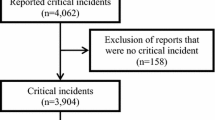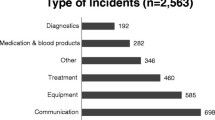Abstract
Manual incident reports significantly under-report adverse clinical events when compared with automated recordings of intraoperative data. Our goal was to determine the reliability of AIMS and CQI reports of adverse clinical events that had been witnessed and recorded by research assistants. The AIMS and CQI records of 995 patients aged 2–12 years were analyzed to determine if anesthesia providers had properly documented the emesis events that were observed and recorded by research assistants who were present in the operating room at the time of induction. Research assistants recorded eight cases of emesis during induction that were confirmed with the attending anesthesiologist at the time of induction. AIMS yielded a sensitivity of 38 % (95 % confidence interval [CI] 8.5–75.5 %), while the sensitivity of CQI reporting was 13 % (95 % CI 0.3–52.7 %). The low sensitivities of the AIMS and CQI reports suggest that user-reported AIMS and CQI data do not reliably include significant clinical events.
Similar content being viewed by others

References
Lerou JG, Dirksen R, van Daele M, Nijhuis GM, Crul JF. Automated charting of physiological variables in anesthesia: a quantitative comparison of automated versus handwritten anesthesia records. J Clin Monit. 1998;4(1):37–47.
Thrush DN. Are automated anesthesia records better? J Clin Anesth. 1992;4(5):386–9.
Driscoll WD, Columbia MA, Peterfreund RA. An observational study of anesthesia record completeness using an anesthesia information management system. Anesth Analg. 2007;104(6):1454–61.
Sandberg WS, Sandberg EH, Seim AR, Anupama S, Ehrenfeld JM, Spring SF, Walsh JL. Real-time checking of electronic anesthesia records for documentation errors and automatically text messaging clinicians improves quality of documentation. Anesth Analg. 2008;106(1):192–201.
Benson M, Junger A, Fuchs C, Quinzio L, Bottger S, Jost A, Uphus D, Hempelmann G. Using an anesthesia information management system to prove a deficit in voluntary reporting of adverse events in a quality assurance program. J Clin Monit Comput. 2000;16(3):211–7.
Cook-Sather SD, Gallagher PR, Kruge LE, Beus JM, Ciampa BP, Welch KC, Shah-Hosseini S, Choi JS, Pachikara R, Minger K, Litman RS, Schreiner MS. Overweight/obesity and gastric fluid characteristics in pediatric day surgery: implications for fasting guidelines and pulmonary aspiration risk. Anesth Analg. 2009;109(3):727–36.
Conflict of interest
The authors declare that they have no conflict of interest.
Author information
Authors and Affiliations
Corresponding author
Additional information
IRB: IRB approval was obtained; the requirement for written informed consent was waived by the IRB.
Rights and permissions
About this article
Cite this article
Simpao, A.F., Pruitt, E.Y., Cook-Sather, S.D. et al. The reliability of manual reporting of clinical events in an anesthesia information management system (AIMS). J Clin Monit Comput 26, 437–439 (2012). https://doi.org/10.1007/s10877-012-9371-z
Received:
Accepted:
Published:
Issue Date:
DOI: https://doi.org/10.1007/s10877-012-9371-z



